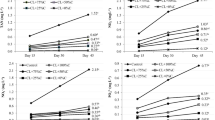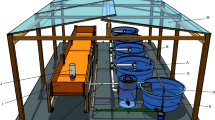Abstract
Murray Cod, Maccullochella peelii peelii (Mitchell), and Green Oak lettuce, Lactuca sativa, were used to test for differences between three hydroponic subsystems, Gravel Bed, Floating Raft and Nutrient Film Technique (NFT), in a freshwater Aquaponic test system, where plant nutrients were supplied from fish wastes while plants stripped nutrients from the waste water before it was returned to the fish. The Murray Cod had FCR's and biomass gains that were statistically identical in all systems. Lettuce yields were good, and in terms of biomass gain and yield, followed the relationship Gravel bed > Floating > NFT, with significant differences seen between all treatments. The NFT treatment was significantly less efficient than the other two treatments in terms of nitrate removal (20% less efficient), whilst no significant difference was seen between any test treatments in terms of phosphate removal. In terms of dissolved oxygen, water replacement and conductivity, no significant differences were observed between any test treatments. Overall, results suggest that NFT hydroponic sub-systems are less efficient at both removing nutrients from fish culture water and producing plant biomass or yield than Gravel bed or Floating hydroponic sub-systems in an Aquaponic context. Aquaponic system designers need to take these differences into account when designing hydroponic components within aquaponic systems.
Similar content being viewed by others
References
Adler PR, Harper JK, Takeda F, Wade EM, Summerfelt ST (2000a) Economic evaluation of hydroponics and other treatment options for phosphorous removal in aquaculture effluent. Hortic Sci 35:993–999
Adler PR, Harper JK, Wade EM, Takeda F, Summerfelt ST (2000b) Economic analysis of an aquaponic system for the integrated production of rainbow trout and plants. Int J Recirculat Aquacult 1:15–34
Alleman JE, Preston K (2002) Behaviour and physiology of nitrifying bacteria. Web archive of the Aquaculture Network Information Centre. http://www.aquanic.org/publicat/state/il-in/ces/ces-240_biology.htm
Burgoon PS, Baum C (1984) Year round fish and vegetable production in a passive solar greenhouse. In: Proceedings of the 6th international congress on soiless culture, Luntern, Netherlands, 28 April–5 May, pp 151–172
Dontje JH, Clanton CJ (1999) Nutrient fate in aquaculture systems for waste treatment. Trans Am Soc Agric Eng 42:1073–1085
Goto E, Both AJ, Albright LD, Langhans RW, Leed AR (1996) Effect of dissolved oxygen concentration on lettuce growth in floating hydroponics. Proceedings of the international symposium in plant production in closed systems. Acta Horticult 440:205–210
Graves CJ (1993) The nutrient film technique. Horticult Rev 5:1–44
Imsande J, Touraine B (1994) N demand and the regulation of nitrate uptake. Plant Physiol 105:3–7
Ingram B (2002) Murray Cod aquaculture: now and into the future: outcomes from a project investigating the intensive commercial production of Murray Cod. In: Murray Cod aquaculture: now and into the future. Proceedings from a workshop held at the Victorian Institute of Animal Sciences, Attwood, Victoria, Australia, 5 August 2002
Lennard WA, Leonard BV (2004) A comparison of reciprocal flow verses constant flow in an integrated, gravel bed, aquaponic test system. Aquacult Int 12:539–553
Lewis WM, Yopp JH, Schramm HL, Brandenburg AM (1978) Use of hydroponics to maintain quality of recirculated water in a fish culture system. Trans Am Fish Soc 197:92–99
Masser MP, Rakocy JE, Losordo TM (1999) Recirculating aquaculture tank production systems: management of recirculating systems. Southern Regional Aquaculture Centre Publication No. 452. Southern Regional Aquaculture Centre, USA
McMurtry MR, Sanders DC, Patterson RP, Nash A (1993) Yield of tomato irrigated with recirculating aquaculture water. J Prod Agric 6:429–432
McMurtry MR, Sanders DC, Cure JD, Hodson RG, Haning BC, St. Amand PC (1997) Efficiency of water use of an integrated fish/vegetable co-culture system. J World Aquacult Soc 28:420–428
Morgan L (1999) Hydroponic lettuce production. Casper Publications, Narrabeen, NSW, Australia
Naegel LCA (1977) Combined production of fish and plants in recirculating water. Aquaculture 10:17–24
Rakocy JE, Hargreaves JA (1993) Integration of vegetable hydroponics with fish culture: a review. In: Wang JK (ed) Techniques for modern aquaculture. American Society of Agricultural Engineers, St. Joseph Michigan USA, pp 112–136
Rakocy JE, Bailey DS, Shultz KA, Cole WM (1997) Evaluation of a commercial-scale aquaponic unit for the production of Tilapia and lettuce. In: Tilapia aquaculture: proceedings from the 4th international symposium on Tilapia in Aquaculture. Northeast Regional Agricultural Engineering Service, Ithaca, New York, pp 603–613
Salsac L, Chaillou S, Morot-Gaudry JF, Lesaint C (1987) Nitrate and ammonium nutrition in plants. Plant Physiol Biochem 25:805–812
Seawright DE, Stickney RR, Walker RB (1998) Nutrient dynamics in integrated aquaculture-hydroponic systems. Aquaculture 160:215–237
Singe S, Marsh LS, Vaughan DH, Libey GS (1996) A computer simulation model to optimise greenhouse size for an integrated (fish production, hydroponics) system. Trans Am Soc Agric Eng 39:2241–2248
Waten BJ, Busch RL (1984) Tropical production of Tilapia (Sarotherodon aurea) and tomatoes (Lycopersicon esculentum) in a small-scale recirculating water system. Aquaculture 41:271–283
Wren SW (1984) Comparison of hydroponic crop production techniques in a recirculating fish culture system. MSc thesis, Texas A&M University, Texas, USA
Acknowledgements
This research was partially funded by the Australian Federal Governments Rural Industry Research and Development Corporation (RIRDC). The authors also wish to thank Boomaroo Nurseries (Lara, Victoria, Australia) for the provision of the many lettuce seedlings used to complete this study and Dr. Brett Ingram of the Victorian Institute of Marine and Freshwater Research for his invaluable knowledge of Murray Cod culture.
Author information
Authors and Affiliations
Corresponding author
Rights and permissions
About this article
Cite this article
Lennard, W.A., Leonard, B.V. A Comparison of Three Different Hydroponic Sub-systems (gravel bed, floating and nutrient film technique) in an Aquaponic Test System. Aquacult Int 14, 539–550 (2006). https://doi.org/10.1007/s10499-006-9053-2
Received:
Accepted:
Published:
Issue Date:
DOI: https://doi.org/10.1007/s10499-006-9053-2




